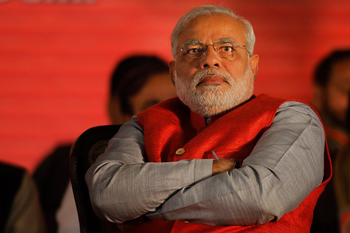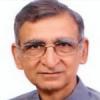 As Narnedra Modi was close to being nominated the Prime Ministerial candidate, another Modi, Sushil Modi, flaunted Modi’s backward caste origins. Recently (Jan 2014) in a public rally in Delhi, Narerndra Modi himself brandished his caste while speaking at a public rally. At one level it is surprising that Modi is showcasing his caste, as the aim of RSS, whose trained swayamsevak (volunteer) he is, is to forge a monolithic Hindu identity, papering over the caste differences and underplaying its inherent hierarchy. Hindutva, the RSS politics, is essentially an ideology based on a caste pyramid, where the different castes have a well defined place. The caste system gets its strength through subordinating the dominated castes. Dominated castes, dalits-OBCS, assuming Hindu identity, over and above their caste identity, is the fulcrum of strength of Hindutva politics.
As Narnedra Modi was close to being nominated the Prime Ministerial candidate, another Modi, Sushil Modi, flaunted Modi’s backward caste origins. Recently (Jan 2014) in a public rally in Delhi, Narerndra Modi himself brandished his caste while speaking at a public rally. At one level it is surprising that Modi is showcasing his caste, as the aim of RSS, whose trained swayamsevak (volunteer) he is, is to forge a monolithic Hindu identity, papering over the caste differences and underplaying its inherent hierarchy. Hindutva, the RSS politics, is essentially an ideology based on a caste pyramid, where the different castes have a well defined place. The caste system gets its strength through subordinating the dominated castes. Dominated castes, dalits-OBCS, assuming Hindu identity, over and above their caste identity, is the fulcrum of strength of Hindutva politics.
Caste has been the major phenomenon, with which the Hindutva politics had to engage with. The beginning of RSS was more as a reaction to low castes coming up in the society. In 1920s when the dalits launched Non Brahman movement, aimed to fight against landlord-Brahmin combine, the upper castes, came forward to lay the foundation of RSS. This formation was aiming at Hindu Nation, in contrast to the agenda of Ambedkar who was talking of caste annihilation and was conceptualizing the concept of social justice in the framework of rising Indian Nationalism. RSS was also opposed to the national movement, which recognized the need for transformation of caste hierarchy, towards the values of equality. At this point of time the Hindutva ideologues like Golwalkar, upheld the Hindu holy books which had caste equations ingrained in them. These ideologues, overlooking the cruelty of caste system, glorified it as the basis and strength of Hindu society. With independence and the coming into being of Indian Constitution the march of dalits towards equality took the next step aided by the affirmative action provided by Indian Constitution. They did start the journey for their own share sky.
The changes in social scenario by 1980s led to a situation whereby upper caste felt that this undeserving section is being treated like ‘son-in-laws’ of the Governments in matters of education and jobs. They felt that their ‘deserving’ children are not able to get their due share of admissions and jobs. The result was anti-dalit violence in Ahmadabad in 1980s. Later the anti OBC violence in mid 1980s, opposing the promotion of OBCs in jobs was witnessed. With Mandal Commission coming in 1990s, the discomfort of upper caste was articulated by RSS progeny, who for electoral compulsions did not formally oppose the Mandal but diverted the social attention by enhancing the mobilization for Ram temple in a big way.
Meanwhile RSS planned for social engineering by which the dalits were co-opted into Hindutva politics and at places put in the forefront like in Babri demolition and also in the anti Muslim violence in Gujarat in particular. The anti-minority violence plays the role of bringing religious identity o the fore. In case of dalits through communal violence ‘Hindu identity’ came in as the overshadowing one, overshadowing the caste identity. After every case of anti minority violence, the Hindu identity became bigger for dalits. The recent case of Muzzafarnagar violence is the good example to observe this phenomenon. Here the Jats-Muslim bridges were broken through this violence and more so by transforming the Jat identity to the Hindu identity, by showing the fear of Muslims. Earlier also through this social engineering the dalit OBCs like Uma Bharati, Kalyan Singh, Vinay Katiyar have been brought in the forefront of RSS scheme of politics, through the act of Babri demolition and other related communal agenda. With this social engineering one can see the section of dalits veering towards this divisive politics.
At another level there is a conscious ploy through floating organizations like Samajik Samrasta Manch (Social Assimilation Platform), which talks of caste harmony while retaining caste inequality. This idea is in total contrast to the idea of Ambedkar for whom caste annihilation had to be the central agenda of dalit politics. While Ambedkar painfully drew attention to the plight of dalits and struggled for justice for them RSS has subtly and openly opposed the affirmative action for dalits and never raised its voice against atrocities on dalits. Agenda of communal politics is a clever ploy. At one level it opposes all affirmative action for the dominated castes, at another level it co-opts them and at yet another level it talks of harmony between different castes.
There is a twin track strategy as far as caste question is concerned. On one side it aims to project Modi’s backward caste identity, and this is for an electoral appeal. At another level it also aims to bring in overarching Hindu identity over and above the caste identity, while retaining the caste pyramid. The overarching Hindu identity is constructed through communal violence, through projecting the fear of the ‘other’, Muslim or Christian, as the one’s threatening ‘we the Hindus’. At ideological level it propagated ‘Integral Humanism’ propounded by Deendayal Upadhyay. This concept of Integral Humanism says that we Hindus believe that different Varnas have come from same Virat Purush (Grand Man). From his mouth came Brahmins, from arms Khstriyas, from thighs Vaishyas and from feet the Shudras were created. It menas that all these Varnas-castes are complimentary to each other.
Modi took this concept to spiritual level, in his recent book, Karmayoga, published by the state information department. In this book Modi says, “Scavenging must have been a spiritual experience for the Valmiki caste, “At some point of time, somebody must have got the enlightenment that it is their (Valmikis’) duty to work for the happiness of the entire society and the Gods; that they have to do this job bestowed upon them by Gods; and that this job of cleaning up should continue as an internal spiritual activity for centuries. This should have continued generation after generation. It is impossible to believe that their ancestors did not have the choice of adopting any other work or business.” This spiritual experience is reserved for the ‘Valmikis’, a sub-caste among Dalits, which has been condemned to scavenging jobs for centuries. The functions of the caste are also being glorified and propagated by many a Godmen, one of whom Pandurang Shastri Athwaley clearly stated that any deviation from the pre-assigned caste duty is detrimental for the society. Another God man Sri Sri Ravi Shanker has been propagating about caste harmony through his writing.
There is no linear relationship between this politics and its strategies. This politics, Hindutva, wants to uphold the caste hierarchy in a subtle way and adopts different tactics in dealing with the caste question. Undoubtedly once the non upper caste become assertive as ‘Hindus’ through ideological indoctrination and become icons of Hindutva politics; that is the biggest ‘success’ of this politics. Modi being a Hindutva icon, being an OBC, is a big leap for Hindutva agenda of upholding caste system and at the same time making stronger forays on the electoral battlefield.








Comments
Wysmienity dobór sily zasilacza dazy od niniejszego, co pragniemy nim zasilic Tedy oraz,
skoro przedkladaja Malzenstwo osiagnac oswietlenie LED zaklinam pamietac: Zasilacze do rozjasnienia LED opracowuja na strumieniu stanowczym DC, na wzburzeniu 12V (wylacznie 24V neony wymuszaja bolesniejszego natezenia
My page; Tasma swiecaca 300 LED wodoodporna 5050 Zimny bialy: http://webmall.inuoo.com/comment/html/?2852.html
Add new comment